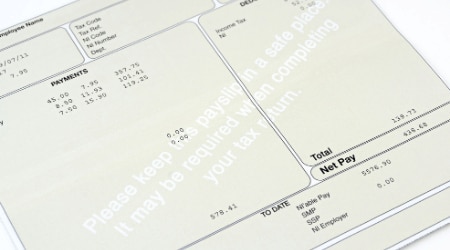In this article, you will learn:

Pay slip Template: Components & Procedure to Prepare a Pay slip
Employers must give a pay slip to every employee working in their organisation.
These pay slips must be given by the employer within the time limit prescribed for giving the pay slips and for the salary period or periods to which such a Pay slip relates.
Pay slip regulations vary greatly by country, for example, in South Africa, you are required by pay wages due within 15 minutes of the start or end of the working day, while in Australia, you have to issue a Pay slip to an employee within 1 working day of pay day, even if an employee is on leave.
So let’s understand what a pay slip is, what are the various components of a pay slip, and finally, have a look at the pay slip template.
Also Read: Try QuickBooks Online Accounting Software for Global
What is a Pay slip?
The employees receive a salary in return for the services rendered by them to their employer. The details of such remuneration are contained in a document that is called a pay slip.
In other words, a pay slip is a document that comprises the components of the salary received by the employee for the services rendered to the employer under the contract of service.
In some countries, pay slips may be given as an electronic copy or a hard copy. In recent years, more countries have adopted mandatory electronic payroll and pay slips.
What is an Itemised Pay slip?
An itemised pay slip is nothing but a pay slip that contains details of information regarding components of salary item by item that is paid to the employees.
Providing itemised pay slips to employees is a good HR practice as employees become aware of their salary components. Furthermore, itemised pay slips help in resolving disputes over salary if any.
An itemised pay slip is given to all the employees and is typically given at the time of paying salary to the employee.
Frequency of Paying Salary
As mentioned above, itemised pay slips are issued to the employees at the time of paying salary to them. Thus, it is important to understand for you as an employer how often can you issue salary to your employees.
In some cases, you may choose to pay the salary at shorter intervals say biweekly. In such a case, there would be more than one salary period within a particular month. Thus, you may consolidate all the salary payment details in respect of that calendar month into a single itemised pay slip. And such pay slips can be given on the day when you choose to pay your employees.
Maintaining Records of Pay slips
As an employer, you are required to maintain a record of all pay slips as per the payroll policy of your country.
Components of an Itemised Pay slip
An itemised pay slip may contain some or all the following items:
- Full name of the employee
- Date of payment (or dates, if the pay slips consolidate multiple payments)
- The basic salary or rate of pay
- Start and end date of the salary period
- Allowances paid for salary period, including transportation allowances and ad-hoc allowances such as for a uniform
- Any other additional payment for each salary period, such as Bonuses
- Rest day pay
- Public holiday pay
- Deductions made for each salary period, including fixed deductions (ex. employee’s pension contribution) and ad-hoc deductions (ex. deductions for no-pay leave, absence from work)
- Overtime pay for overtime hours worked
- Start and end date of the overtime payment period (if different from item 4)
- Net salary paid in total
You may skip specific items/items from the pay slip if these do not apply to a particular employee. For instance, if overtime pay does not apply to a specific employee, you would exclude item 10 and item 11 from the pay slip.













